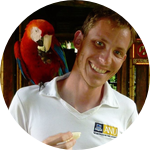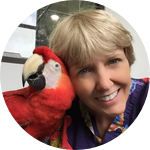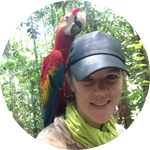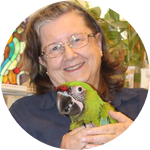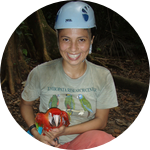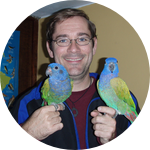About This Project
Scarlet Macaw populations are declining due to illegal trade and habitat loss 1, 2. Unfortunately, macaws lay 2-4 eggs, but fledge only one/two chicks, letting the others starve to death. Last year we used chick fostering to save 11 chicks from starvation. This year we will refine our techniques to make them better and simpler, to encourage other parrot conservation projects to use these techniques to aid the recovery of endangered species of macaws & parrots throughout the Americas and beyond.
Ask the Scientists
Join The DiscussionWhat is the context of this research?
Our team has studied Scarlet Macaws for over three decades 1. From our research we know that over 20% of all Scarlet Macaw chicks die of starvation and that starvation is the most common cause of death for wild macaw chicks. Parents always raise the first chick, but 45% of second chicks, nearly all third chicks and all fourth chicks starve to death. Few studies have shown how to accomplish chick adoptions successfully 3, 4, 5, 6.
Our experience last year showed we can move chicks at risk of starvation to nests of foster parents with one chick and help them survive. Now we need your help to simplify and finish testing these techniques so they can be used around the world to save parrots at risk of extinction.
What is the significance of this project?
Scarlet Macaw numbers are critically low in Mexico and Guatemala, with population numbers below 500 birds total 7. It's too risky to test new field techniques in areas with rapidly declining populations, but we work in Tambopata where they are not decreasing yet.
This gives us a unique advantage to test whether we can increase the survival of macaw chicks by moving third chicks to nests with one or no chicks. This technique has great potential to aid in the recovery of Scarlet Macaw populations in areas where they are critically low.
After our first trials' success, we have been sharing our results & recommendations through conferences. Reintroduction biologists are very excited that our techniques work so well.
What are the goals of the project?
Our main goal is to increase survival of wild Scarlet Macaw chicks by thoroughly developing and testing techniques that help to reduce wild macaw chick starvation. Based on previous data, we estimate that there will be at least 15 chicks at risk of starvation in the upcoming breeding season. We aim to translocate all these chicks to foster parents.
Macaw nests will be checked every day after the first chick hatches in order to find second and third chicks as soon as they hatch. The chicks selected for relocation will be removed from the nest and raised by researchers until they are ready. At this point, they will be placed into their adoptive nest and the family will be intensively monitored by a vet to ensure that the new chick is successfully adopted.
Budget
Funds for rearing translocated macaw chicks will provide hand-feeding supplies, chick measuring equipment, and car batteries along with salary for an avian veterinary to raise and check the health of newly hatched macaw chicks.
Funds for climbing and checking macaw nests will provide wood and labor to maintain macaw nest boxes used by the breeding adults, tree climbing equipment for monitoring nests and hard drives to store important data and images.
Foster chick monitoring funds will provide salary for a field veterinary in charge of monitoring foster chicks acceptance in foster nests. We have learned that foster chicks acceptance by foster parents is a SLOW process and needs to be closely monitored by a vet.
*If we raise more than our target value, we will be able to continue our work through the next season and save additional chicks.
Endorsed by
 Project Timeline
Project Timeline
The project will last approximately 3 months, from December 2018 to mid-February 2019. We predict that first macaw chicks will be hatching by late-November. So we will have third chicks hatching by mid-December, with the possibility of more late hatches by mid-January. Chicks will be relocated into their adoptive nests approximately 20 days after hatching and will continue to be monitored inside their nests until they fledge.
Nov 03, 2018
Project Launched
Nov 07, 2018
Project Launched
Nov 26, 2018
26 Nov, 2018 to 15 Jan, 2019 Scarlet Macaw chicks for translocation will start hatching
Nov 28, 2018
28 Nov, 2018 to 15 Jan, 2019 Macaw Chicks will be raised and get ready for foster nests
Dec 10, 2018
10 Dec, 2018 to 30 Jan, 2019 Macaw chicks will be placed in adoptive nests
Meet the Team
Team Bio
The Tambopata Macaw Project is a long term research project on macaw and parrot conservation and ecology in the lowlands of southeastern Peru. It was founded by Eduardo Nycander of Rainforest Expeditions in 1989 and directed by Dr. Donald Brightsmith since 1999. Its work with parrots and macaws, local communities, and government agencies has provided many insights into various aspects of these wonderful macaw and parrot species in the wild.
Shannan Courtenay
I was lucky to grow up spending much of my time outdoors in New Zealand and developed a love for animals and the natural world at a very young age. This grew into a strong drive to conserve biodiversity and whole ecosystems. I believe we have a responsibility to protect the environment and the entirety of the life within it.
After I received my wildlife biology and conservation ecology degree at La Trobe University in Australia, I was drawn to the lowland jungles of Peru because of their high biodiversity. Since then, I have been volunteering for The Tambopata Macaw Project because I believe this work is so valuable to the long-term conservation of parrots and macaws, which has a positive impact on whole ecosystems throughout Latin America.
The people involved in this project are experts in their field and work extremely hard to gather reliable scientific data which can be used to help parrots worldwide. I know that they truly appreciate every single cent given and will ensure it goes a long way to helping these species.
Janice Boyd
Dr Janice Boyd is a researcher on parrot conservation and parrot genetics issues at the Schubot Exotic Bird Health Center at the Texas A&M Veterinary School. She also is president of the nonprofit 501(c)(3) Amigos de las Aves USA, also known as simply the Parrot Fund, that supports projects on wild and ex-situ parrot conservation and health, particularly in the Neotropics. She has been a key collaborator of the Tambopata Macaw Project since 2000.
Gabriela Vigo Trauco
I consider myself a parrot lover and wild psittacine researcher. I have been around parrots since I was 5 years old and I have been working with them in the wild, as part of the Tambopata Macaw Project, since 2003. I have also worked with parrots and macaws in captivity.
For the last 12 years, I have dedicated myself to the study of Scarlet Macaws in the wild in my native Peru, to try understand their breeding strategies and breeding behavior. Through all these years of hard field work, we have gathered unique scientific information that we are now using to design management strategies to help wild populations of Scarlet Macaws increase in numbers.
I am very excited that we have the chance to apply all the knowledge we have about this macaws to have a real impact in wild populations that are in trouble. I truly believe we have the knowledge to help them.
Donald J. Brightsmith
I am a tropical ecologist and conservation biologist who works on a variety of topics in parrot conservation, health and welfare. Back in the early 90's I read a book called "Neotropical Parrots in Crisis" and I realized that this family of beautiful, smart and charismatic birds were in great danger of extinction but we knew very little about them. So, I decided to dedicate my career and my life to study them in the wild and captivity and to promote their conservation. Since 1999, I have directed the Tambopata Macaw Project in the Amazon rainforest of Peru. There, after decades of hard work in the field, we have discovered many interesting aspects of macaw and parrot natural history. We are eager to use this information to implement management techniques to increase macaw and parrot populations that are declining throughout the Americas. Many colleagues are interested in using this information as well. We have the science, we know what to do, now we need your help to make it happen.
Additional Information
We´ve got a proven track record:
The Tambopata Macaw Project is one of the longest running parrot research programs in the Americas and our research has been making a positive impact on Scarlet Macaw populations for almost 30 years. Since 1989, we have studied wild Scarlet Macaws in the lowland rainforests of southeastern Peru 7 . Since 1999, under the direction of Dr. Donald Brightsmith, the project has been instrumental in determining the life history traits, breeding behavior, chick growth, and development of Scarlet Macaws 8,9,10. During this time, we have been able to discover so much about how this species live and interact in the wild 11,12,13. Besides this, we have been able to contribute to their conservation and help other projects use our techniques to help their own populations 14,15.
Last year we used this new ´foster chick´ program on chicks that were at risk of starvation and 100% of the foster chicks survived. Now we are asking your help to run this program on a larger scale, to save more Scarlet Macaw chicks and allow us to share this vital information with other conservation programs around the world.
Please help us reach our goal for saving Scarlet Macaws.
$5 will help buy supplies for hand-feeding macaw chicks.
$10 will help to buy supplies for health monitoring and equipment to keep them warm.
$25 will help buy equipment to keep track of their growth, development and health.
$50 will help buy new wood to repair Scarlet macaw artificial nests each season so that they have somewhere to raise their young.
$100 will help buy new ropes and harnesses so our climbers can access the nests and track the chick’s growth
$500 help provide salary for a qualified veterinarian to carry out this important work in the field
You know how important it is to conserve this species, but not everyone does. With your help, this research can aid the recovery of other highly endangered species. Please share this campaign via Facebook or email to anyone you think might want to help.
To find out more please visit: https://en.wikipedia.org/wiki/...
Thank you so much for donating to our campaign.
Video Credits:
Video Editing: Keith Regelmann
Original Footage from: Scott Echols and Wildlife Messengers (wildlifemessengers.org)
Project Backers
- 46Backers
- 121%Funded
- $5,956Total Donations
- $129.48Average Donation

